Medieval: Total War Updated Preview
This impressive large-scale strategy game has come a long way since we saw it last. Get the latest details on Medieval here.
Creative Assembly's Shogun: Total War made real-time strategy game fans everywhere sit up and take notice when it was released in 2000. Shogun did something totally unique: It let players fight huge battles with armies of thousands of individual samurai over the course of a century-long struggle in ancient Japan. Until then, no one had ever attempted to create as ambitious a game with that kind of scale, and no one had done so since. That is, until Creative Assembly decided to expand on Shogun with its next game, Medieval: Total War, a game that will pack 400 years of European war history into a colorful, accessible, and very good-looking real-time strategy game. Fortunately for us, the developer was kind enough to pay us a visit with the latest version of the game, and judging from what we've seen, Medieval will absolutely, positively live up to the "Total War" moniker.
Shogun let you fight large, real-time battles between a few thousand troops. Medieval will let you have gigantic battles between 16 different companies of different soldiers on the field at one time--up to 15,000 individual units on the same battlefield simultaneously. And this isn't some far-off, theoretical plan for the game either. We watched these enormous battles firsthand--massive melees between thousands upon thousands of troops in real time. According to the developers, Medieval will actually have about four times the level of unit detail as in Shogun, and it indeed looks this way. Unlike Shogun, in which soldiers looked like simple but functional 3D characters, in Medieval, individual units wear colored tabards that clearly indicate which side they're on and also wear detailed armor suited to their home nation. The game has 12 playable factions in all, including countries in Eastern and Western Europe, the Middle East, and the Mongol horde from Shogun: Warlord Edition. The game's four-part soundtrack will actually correspond to these four regions, though just like in Shogun, the soundtrack will be dynamic and will change with the tide of battle. What's more, Medieval's battles will take place on huge battlefields that will be up to four times the size of those in Shogun, and like Shogun, Medieval won't have the artificial constraint of fog of war--if you can't see an enemy company, it's because that group is hiding within a ravine or behind a hill on the game's fully 3D terrain, not because you haven't explored that area yet.
With that in mind, Medieval isn't just going to be a bigger game with bigger armies, bigger maps, and bigger battles. Though the game will have about 100 different unit types, including archers, knights, spearmen, crossbowmen, swordsmen, and many, many more, all of these units will fight differently in battle. Medieval will have all-new tactical considerations, such as the increased defensive strength of densely packed formations of pikemen to meet charges and the new ability of cavalry to actually smash right through infantry squads and disrupt their formations while charging. Units will also be more responsive in disengaging orders so that if a particular skirmish is going badly, you won't have to sit there and wait for it to resolve--for example, we watched an overwhelmed cavalry regiment, which was quickly called back to attention and ordered to regroup.
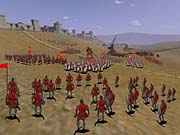
And every unit will have to be wary of artillery, especially cannons, whose powerful fire can scatter the ranks of most mounted and infantry soldiers. Cannonballs will not only smash through footmen but, as we saw firsthand, also actually kick up a cloud of dust and bounce through enemy ranks, taking down even more troops, and just as in the real battles of the Middle Ages, they'll become more accurate the longer they remain in place while firing on a single target. In other words, foolish warlords who attempt to cower in one place behind rows of halberdiers will receive a very rude awakening from the business end of their enemies' cannons, which will dash most infantry and cavalry units to pieces. Fortunately, cannons themselves are by no means an easy, no-risk means of doing battle, since they're extremely expensive to build and very slow to move--plus, they require lots of troops to man them and even more to sustain a decent rate of fire. And just like in the Middle Ages, cannons can and will misfire, explode, and take their cannoneers with them.
If I Were King
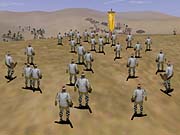
As you might expect, the sight of enemy cannons tearing through your own ranks won't exactly set your troops at ease. Medieval will have an expanded morale system that will take into account not only the general pace of battle but also each company's fatigue level, the weather conditions on the battlefield, and even the sight of all those unsightly corpses that tend to pile up in the game's fierce battles. That's not to say that you'll be baby-sitting each of your companies, because although morale will be an important concern, it won't be the only factor that governs the tide of battle. For instance, Medieval's fully 3D terrain will allow for height advantages on hills and mountains--especially in the case of archers and artillery, as well as for hiding places for smaller companies--and cover from enemy fire, especially in dense forests. And you'll want to be especially careful during sieges of villages and castles--you might want to storm your enemies' towers with your troops up close and your artillery from afar, but destroying buildings can bring huge piles of rubble crashing down on the heads of any unlucky onlookers.
Depending on the way you want to play your game, you'll also want to keep an eye out for your enemy's general, since capturing or killing the head of the opposing army will lower your enemy's morale considerably. Attack the enemy general with a group of unkempt mercenary soldiers, and they'll most likely cut him down immediately. Attack the enemy general with a battalion of chivalrous knights, and they may instead take him captive--your troops' level of discipline determines their behavior--after which you can ransom the enemy general or put him to death.
Your behavior in situations like these will actually affect you and the way other nations of the world view you, at least in the game's lengthy and extremely varied single-player campaign. You, your vassals, and all of your enemies will have five statistics: piety, influence, acumen, command, and dread. While acumen and command pertain to your holdings and your general military power, influence is a measure of how much sway you have over your own people and the people outside of your borders. You can increase your influence by conquering your neighbors, but more Machiavellian rulers will have the option to marry off any winsome princesses, who happen to belong to their households, to the ruling family of another country--and if they do so, they'll gain rights to a dynastic claim on the rulership of that country, which can come in handy especially if that country is in a state of unrest.
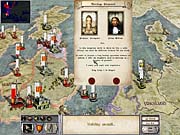
Wise rulers will make sure that their own people are kept well in check, either by acting to increase their own piety level by building religious structures and donating to the church to make themselves more popular or by acting to increase their own dread level by performing acts of cruelty, like executing hostages. You can create a truly fearsome ruler by increasing your dread level, but you'll also create civil unrest within your own country, and if your ruler happens to be killed on the battlefield or assassinated in secret, your nation may be plunged into civil war. You can change these qualities over the course of the game, as well as gain other miscellaneous attributes, called vices and virtues. These may help or hurt your ruler's reputation and performance at home, abroad, or on the battlefield--successful, aggressive generals might get the favorable "mighty warrior" virtue, while an unpopular ruler who has somehow managed to survive multiple assassination attempts might get the "paranoid" vice and begin executing his courtiers at random.
And in keeping with the game's historical theme, you and your generals can and will encounter famous historical figures and reap the benefits (and suffer the consequences) of major historical events. Over the course of the game's campaign, which can be played in three different segments--the early Middle Ages, the high Middle Ages, and the late Middle Ages--or as a single, continuous whole, you'll meet Joan of Arc, King Richard the Lionheart, El Cid, and William Wallace, who will all participate in the campaign in different ways. You'll also experience major events such as the return of Marco Polo from the Orient, the Black Plague, and the Hundred Years' War. And though eager warlords may wish to jump the gun and begin their own Hundred Years' War against all of their neighbors, more reserved players will want to take advantage of the option to go on Crusade (or, in the case of the Middle-Eastern states, Jihad)--a religious campaign that will let your troops travel unhindered, without provoking hostility, through foreign countries that have the same or similar faith. In fact, a well-timed, intelligently planned Crusade can actually attract followers to your cause--but if, for instance, your Anglican crusaders are foolish enough to try to blunder into the domain of Saladin the Muslim King, they'll receive a much less-friendly reception and may incite war.
After watching the flying dust, the charging soldiers, the breaking formations, and the valiant rallies of Medieval's huge battles firsthand, we're pretty sure that the game's battles will be extremely entertaining, even just to sit and watch. But the developers are aiming for considerable replay value with Medieval--for instance, over the course of the game's three-part campaign, you'll be able to access different technologies, depending on your actions and which country you choose to champion. Devoted warlords will also be able to use Medieval's comprehensive editing tools, which include two types of editors--editors which, according to Creative Assembly's developers, will contain the same tools that they themselves used to build the game.
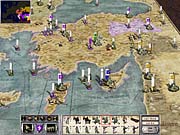
The battle editor will basically be a map editor that will let players create their own battlefields from Medieval's huge pool of different combinations of landscapes and weather types--more than 400 different types of battlefield are possible--creating as many hills, valleys, forests, and cities as they want. The historical battle editor will let players set a lot more variables--how many troops players can start with, their morale, and also which battle they'll move on to next if they win or lose. In other words, the historical battle editor will let players create branching campaigns, with different maps tied together by different victory conditions.
And of course, the greatest way to prolong the life of a real-time strategy game is to equip it with enjoyable multiplayer play. Creative Assembly is making sure that players will be able to duke it out with huge armies without having to deal with an ugly morass of micromanagement. According to the developers, Medieval has three different levels of unit AI: army level, squad level, and individual unit level. Army-level unit AI will react to major changes in battle, while squad-level AI will be more affected by that squad's individual morale level, which may cause it to stand fast in the case of impossible odds or turn and run. Unit-level AI will automatically send wounded units out of harm's way while bringing fresher troops to the fore and may also cause some units to circle, flank, and surround wounded enemies.
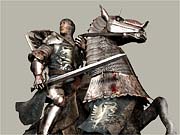
And just as in Shogun, you'll be able to set your different battalions into different formations, including wedge, line, and close (among others), and you'll also be able to group and manage them more easily, thanks to Medieval's streamlined interface, which lets you quickly and easily access each company's current status, issue orders, or completely clear the screen of all icons and interface if you prefer to see nothing but the battle. And you'll see plenty of big battles--big, big battles in multiplayer. As we mentioned, Medieval can support up to 15,000 soldiers on a single battlefield, and a maximum of eight different player-controlled armies can do battle at one time. What's more, you can set as many of those armies as you wish to be computer-controlled AI opponents and conduct epic joint battles with human or computer-controlled allies.
According to the developers, Medieval is very far along and is actually being polished as we speak--minor bugs are being fixed, and some minor features have yet to be added, but the game itself looks like it's definitely on track for its scheduled release in September. We'll have more information on this very impressive strategy game as we get it.
Got a news tip or want to contact us directly? Email news@gamespot.com
Join the conversation